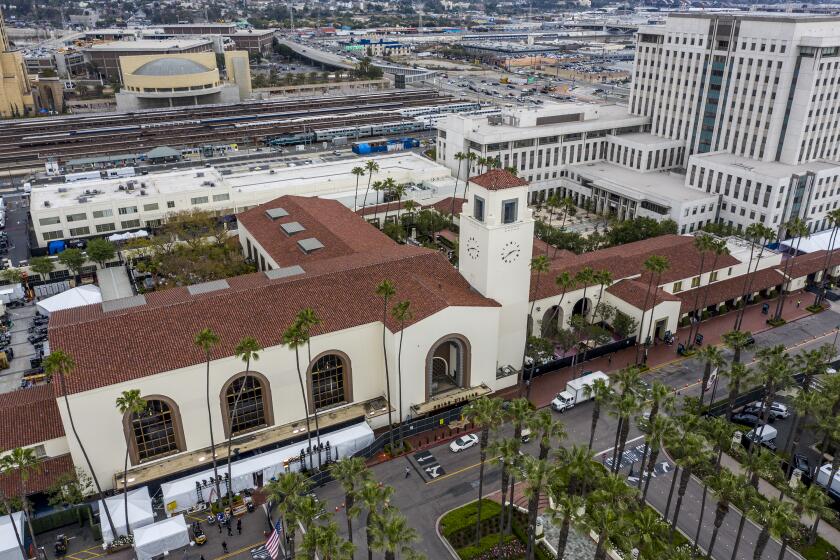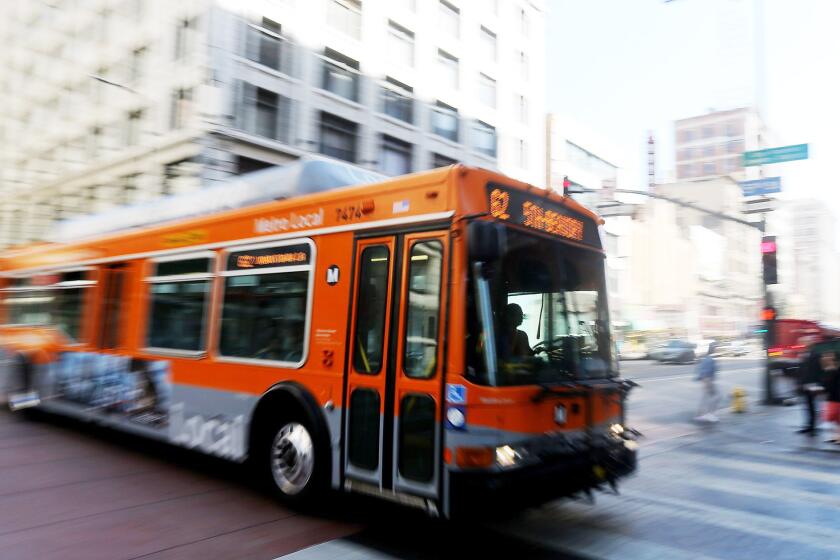Renewed promises to improve safety after the second Metro bus hijacking in 6 months

- Share via
Metro riders were already uneasy using the system during off hours or at certain locations.
Then an armed man hijacked a bus Wednesday morning in a violent takeover that left one passenger dead, and officials tried to reassure Angelenos — who have long been distrustful of promises to improve a transit system that has failed to keep people safe.
“It’s getting scarier,” said Priscilla Russell, a 69-year-old retired juvenile detention officer who, like thousands of low-income residents, relies on the bus to get around.
One person was dead after a gunman hijacked a Metro bus and led police on a low-speed chase that ended in downtown Los Angeles early Wednesday.
“At nighttime it is very unsafe as a woman,” said her daughter Indiglo Russell, who works as a caregiver. “I have to be cautious and make sure I’m looking around.” If someone is acting scary, Indiglo said, “I try not to look them in the eye and escalate.”
It was the second bus hijacking in six months and at least the fifth homicide on the system this year. In May, after 66-year-old security guard Mirna Soza was killed in an unprovoked attack on her way home from work, Mayor Karen Bass ordered a surge of law enforcement. Metropolitan Transportation Authority officials said that more uniformed officers had helped tamp down crime during the summer months, but it hasn’t been enough.
“I’m angry and frustrated,” Metro Chief Executive Stephanie Wiggins said about the incident on Metro Bus 81. “We have been working diligently to address safety and security improvements on our system to make things safer for our employees and our riders.”
But she said these incidents were too common, largely blaming forces beyond a public transportation agency’s control.
Metro greenlights plans to start its own police agency, after years of frustration with the LAPD, Los Angeles County sheriff and Long Beach police.
“It’s also a reflection of the community, and that includes the criminal activity and the weapons that flow onto our buses from our community streets,” Wiggins said.
Metro said that there’s been a 20% surge in law enforcement in the system.
Overall crime numbers are up for the first six months of the year — largely due to officers cracking down on trespassers and fare evaders. Violent crimes are down slightly, but assaults on operators increased from 11 in May to 14 in June and 23 in July, according to Metro.
Metro riders have encountered a spate of violent attacks in recent months. In July, stabbings occurred at Union Station and at Metro’s South L.A. station. In August, a woman was thrown onto the tracks at a Pasadena Metro station and dragged across the concrete divider onto the 210 Freeway.
Police offered few details of the stabbings near bus stops at Union Station and the J Line station on Slauson.
“No one should ever get on a bus or train and wonder if someone has a knife or firearm,” Inglewood Mayor James Butts said at a Metro board meeting Thursday. “We have to let the public know that it is our commitment that we’re going to make our modalities totally impervious to getting on the system with weapons.”
Violence is a problem transit officials across the nation are dealing with. Assaults on transit workers have tripled over the last 15 years, according to research from the Urban Institute.
U.S. Department of Transportation officials announced a directive Wednesday to more than 700 transit agencies intended to better protect front-line workers from risk of assault. Under the new regulations, agencies must conduct risk assessments for transit workers and identify strategies to improve their safety.
“Transit agencies across the country are not doing nearly enough to stop the constant attacks on our members,” Amalgamated Transit Union International President John Costa said in a statement.
He said that once the assessments are done, he hopes agencies “will then pivot immediately to requiring minimum vehicle safety standards for transit buses.”
Critics of Metro said the agency has been late to act, costing lives.
“This is not an isolated incident by any means,” said Orion S. Robinson, a lawyer who is representing the family of a passenger killed last year in an unprovoked attack. “It’s just a continued refusal to address the situation at hand.”
Jesse Michael Rodriguez, 23, was on his way to a friend’s house when he was stabbed by another passenger near Pershing Square in December. Robinson says it was Metro’s lax security and failure to enforce fare and trespassing rules that created dangerous conditions for riders and led to Rodriguez’s death.
“There’s clearly been a rise in criminal conduct and violent events on Metro,” he said. “Clearly there was notice to Metro about what’s going on. The public will agree that this is a major problem for our city and it’s putting a lot of people at risk.”
For months now, the transit board has been grappling with how to improve conditions, launching a program to install protective barriers for bus drivers, creating a test program for gun detectors and vowing to create a Metro police force. But officials acknowledged they have not done enough.
“I think if you ask most riders, they will say they haven’t seen as many uniformed law enforcement officers on the system as they would like to,” Metro board Chair and Los Angeles County Supervisor Janice Hahn said Wednesday. “Having them be more visible, in my opinion, would help deter some crime and maybe even stop crime while it’s happening.”
Metro declares an emergency amid jump in bus driver assaults and seeks to quickly build barriers to wall drivers off from dangerous passengers.
Hahn said that while the city prepares to host the 2026 World Cup and the 2028 Olympics and improve public transportation, she is focused on residents who rely on transit and need immediate change.
“These are the people who are transit dependent.”
Many who work in Los Angeles’ industrial areas rely on the bus to get to and from work for shifts that start well before dawn or end late at night. For a significant population who work in areas such as the downtown Flower Mart or produce warehouses, it’s their only transportation option, said Executive Director Estela Lopez of the Downtown Industrial District business improvement district.
“Some folks ride Metro for environmental reasons — that’s their preferred mode of transportation — but there’s a tremendous population who depend on it to get to work,” Lopez said. “Does something need to happen? Does something need to be better than what is being done now? Hell, yes.”
Lopez, whose organization encompasses Skid Row, said that she has not seen an increase in security and that Metro bus safety is linked with the surrounding neighborhoods.
“What’s happening on the buses doesn’t start on the buses — what’s happening on the streets gets onto the buses,” Lopez said. “Have we seen a decrease in crime? No. Do we expect to see a decrease in crime? No.”
“It’s just blanket lawlessness across the city of Los Angeles,” she said.
Interim LAPD Chief Dominic Choi said in June that nonfatal shootings were down citywide, but homicides had risen nearly 11% compared with the first half of 2023. And the downtown area saw a 15% increase in burglaries compared with the first half of last year.
After the latest incident, officials tried to convince riders that they would bring the situation under control.
“I want to say unequivocally that what happened this morning will not be tolerated,” Bass said Wednesday. “There is no place for this in L.A. and we will be working to ensure that all Angelenos, riders and operators, are safe.”
Times staff writer Jireh Deng contributed to this report.
More to Read
Sign up for Essential California
The most important California stories and recommendations in your inbox every morning.
You may occasionally receive promotional content from the Los Angeles Times.















